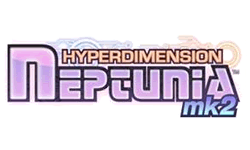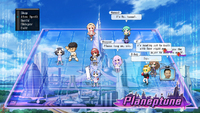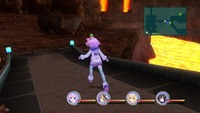|
|

|
PLATFORM
|
PS3
|
BATTLE SYSTEM
|

|
INTERACTION
|

|
ORIGINALITY
|

|
STORY
|

|
MUSIC & SOUND
|

|
VISUALS
|

|
CHALLENGE
|
Easy
|
COMPLETION TIME
|
20-40 Hours
|
|
OVERALL

|
+ Surprisingly enjoyable combat system.
+ Lots of customization options.
+ Quirky story that pokes fun at the game culture.
- Crosses the good taste boundary a few times.
- Not technically impressive.
- Not enough Neptune.
|
Click here for scoring definitions
|
|
|
Brace yourselves, RPGamers, because this is going to shock you. After more than twenty hours, I'm still not sure I even believe it myself. Are you ready? Hyperdimension Neptunia mk2 doesn't suck! If, like me, you've played the original, the chances are you weren't expecting much from a sequel. After all, this was a game whose fundamental mechanics were so broken that they didn't even work mathematically! It's no coincidence that RPGamer awarded it Worst RPG of 2011. But apparently Compile Heart and Idea Factory took the criticisms to heart, and Hyperdimension Neptunia mk2 is such a completely different game that it's almost criminal to compare it to the original in the first place. This is what Hyperdimension Neptunia was meant to be.
For those not familiar with the original, Hyperdimension Neptunia takes place in the half allegory, half parody fantasy world of Gamindustri, where "Console Patron Units" rule over their respective nations, vying for shares of the population's faith. However, the insidious group known as ASIC has been busy spreading stolen goods, all in the hopes of resurrecting the evil deity known as Arfoire. As the game begins, Neptune and the other CPUs are captured. Three years later, with the state of the world the worst it has ever been, it's up to Nepgear, Neptune's little sister, to go out and restore people's faith in the CPUs.
As a general rule, the game is a colossal parody of the Japanese gaming industry, particularly the RPG sector. The game was developed as a collaboration between many popular niche JRPG developers, and many of the characters in the game represent those companies. IF and Compa start things off, representing the lead developers of Idea Factory and Compile Heart. Then there's the little alchemist Gust, representing the developer of the popular Atelier series. 5pb. is a pop star that represents a company relatively unknown in the west that handles a lot of Japanese musical talent. Finally, there's the heroine of justice, Nisa, representing Nippon Ichi Software and Hyperdimension Neptunia's localizer and publisher, NIS America. There's even bit parts for characters representing Cave and Falcom.
The story is ridiculous and silly, the characters are equally goofy, and their antics make up much of the game's charm. While Nepgear is not even remotely as entertaining as Neptune was in the original title, her less vibrant personality allows the quirkiness of the rest of the cast to shine through. In particular, Nisa and Gust get much more, and much deserved, screen time, which they were shortchanged on in the first game. Late in the game, Neptune makes a triumphant return and generally steals the spotlight once again. Unfortunately, Hyperdimension Neptunia mk2 is also much more risqué than the original game, and that's saying a lot considering some of the content of the first. There are several occasions, most of them involving a particularly grotesque boss, that just go a bit too far into perversion territory. Most RPGamers will probably find them to be in quite bad taste.
 Did I mention that Keiji Inafune is a head in a TV box in this game? No? Well, he's a head in a TV box in this game. Oh, and you can hit enemies with his torso. No foolin'!
Did I mention that Keiji Inafune is a head in a TV box in this game? No? Well, he's a head in a TV box in this game. Oh, and you can hit enemies with his torso. No foolin'!
|
|
The story, of course, was not the issue with Hyperdimension Neptunia; it was the gameplay that caused all of its problems. Thankfully, the difference between the original and Hyperdimension Neptunia mk2 is like night and day. The game is complex enough to provide an interesting slew of customization options, engaging enough that it doesn't get boring, but breezy enough that it doesn't get in the way of the game's real draw: the story.
The combat system is entirely turn-based, and is one of the stronger elements of the game's design. Similar to Eternal Sonata, each turn players can move their characters around the battlefield a certain distance, determined by the MOV stat. Once within range of an enemy, a number of different combat options become available. Normal attacks are performed as combos by pressing varying combinations of X, square, and triangle. Each character can have three skills set to each of these buttons, to be performed at a certain stage of a combo, and each skill costs a different amount of AP, a stat the gradually increases over the course of the game. Each button's move list is designed to do a certain thing in combat as well: Triangle attacks are multi-hit techniques that build up hit count, square attacks do major damage, and X attacks reduce an enemy's guard meter, which, once empty, increases the amount of damage dealt to him by a significant amount. To top it off, each character can learn several finishing attacks, which are triggered automatically if the right combination of attacks is used. These finishers also require that a certain amount of AP be expended, and balancing a character's combos to minimize the AP cost and still trigger the finishers is almost a mini-game in itself.
On top of that, characters also have an SP gauge to draw from, which increases whenever they deal or take damage as well as when they end their turn. SP is used to activate special skills, such as healing spells and damaging techniques. Some of these abilities are particularly powerful, and a huge benefit during boss battles. Each character's list of skills is unique, and very few are shared between them, though some have similar effects, like healing spells.
Players will have many customization options open to them as well. In addition to the aforementioned combo system, new weapons and armor become available constantly, and the game offers tons of purely cosmetic upgrades for characters as well. Once the party expands beyond four characters, players will be able to set up a support team in the back row of the party. While these characters don't actually fight in battle, they grant passive bonuses to the character with whom they're partnered. These effects range from nullifying status ailments, increasing experience gain, reducing AP or SP consumption, and in the unique case of Nepgear, removing the damage limit. As a final icing on the cake, there are a total of thirteen characters available to choose from by the end of the game, allowing players a huge well of options to choose from.
If one had to complain about anything in the combat, it's that for the most part the game is quite easy. Thankfully, the combat system is engaging enough and the animations flashy enough that it stays entertaining. The game helps to accomodate this with exceptionally small dungeons that can be fully explored and traversed in minutes. Touching enemies that run around the dungeons begins an encounter, but players can get a preemptive strike by hitting them with their weapon. In the case of really weak enemies, this action will actually destroy them outright, allowing players to revisit dungeons to collect materials with relative impunity. While there are a few dungeons that seem like little more than palette swaps of one another, there is much more variety than in Hyperdimension Neptunia. Considering the general brevity of these areas, most players should be satisfied.
 It takes a while, but Neptune is totally back, and she's totally awesomepants!
It takes a while, but Neptune is totally back, and she's totally awesomepants!
|
|
Outside of combat, there are a whole slew of other things players can engage in. New quests become available all the time, generally requiring players to go out and collect certain items or kill certain monsters. Completing quests affects the shares throughout Gamindustri, increasing them for one faction and reducing them for another. Changing the balance of power in Gamindustri not only affects the ending players receive, but also determines when and if the original CPUs will join your party. Every quest is the game is repeatable as well, which is terrific for players who want to earn some shares while searching for particular items. Players can also engage in item synthesis, a simple system that requires finding a recipe and then collecting the necessary ingredients. In a pleasant twist, players need only create any given item once; once it has been made, it becomes available for purchase in the shop. Finally, for story nuts, Hyperdimension Neptunia mk2 also contains a parody of Twitter, called Chirper. Here, players can see what the various people of each city are saying, and much of it is fairly humorous. Party members also appear here, and some chirps will trigger special event scenes, many of which have additional rewards.
The visuals of Hyperdimension Neptunia mk2 stand as a marked improvement from its predecessor, but they still don't offer up a good example of what the PS3 is capable of. While the models are a bit cleaner and the environments more detailed and colorful, they are nonetheless fairly simple in their design and outclassed by other RPGs with similar budgets, such as the Atelier and Ar Tonelico series. The enemy designs are extremely varied, even amongst enemies of the same "species." A pleasant change is the use of character models in cutscenes rather than still, subtly animated portraits. While the character models aren't as impressive to look at as the portraits, the added animation they provide gives the story some much needed dynamism. Some scenes still retain the portraits, though it's difficult to determine the reason for this.
Hyperdimension Neptunia mk2's audio varies in quality from tolerable to good. The music is charming but not particularly memorable, apart from the extremely catchy opening theme song. Most of the tracks have some sort of electronic, gamey element to them, which adds to the atmosphere. The voice acting is generally fairly decent, but the dialogue is so over-the-top that it's difficult to tell. Certain characters stand out as terrific, particularly Neptune, Nisa, and "Underling," while others are fairly bland, such as Rom and Histoire. In many cases, this is due to the characters' personality more than the acting itself.
Ultimately, Hyperdimension Neptunia mk2 is a much, much better game than its predecessor. While the script isn't as funny as the first and tends to cross the line of good taste a few times too often, the improvements to the gameplay, the more diverse cast, and the better developed world all solidify it as an actually enjoyable game. It's much shorter than the original Hyperdimension Neptunia, clocking in at a little over twenty hours, but in many ways that's a good thing, not a bad thing. I couldn't be more pleasantly surprised.
Review Archives
|









